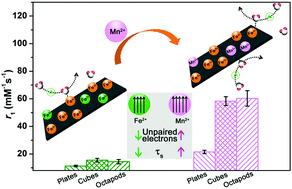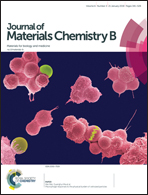Surface manganese substitution in magnetite nanocrystals enhances T1 contrast ability by increasing electron spin relaxation†
Abstract
Magnetite nanoparticles, with good biocompatibility and favorable magnetic properties, have the potential to be the best candidate for non-gadolinium MRI contrast agents. However, they usually show low T1 contrast ability, largely because Fe(II) ions have a short electronic relaxation time and also have a small number of unpaired electrons with inefficient proton relaxation enhancement. Herein, we report a novel strategy to increase the T1 contrast ability of magnetite nanoparticles, through substituting the undesirable Fe(II) ions with Mn(II) ions. Mn(II) ions have a longer electronic relaxation time (10−8 s) and more unpaired electrons (5 unpaired electrons). We successfully construct diverse-shaped manganese ferrite nanoparticles with abundant magnetic ions, Mn(II) and Fe(III), exposed on the surface. These manganese ferrite nanoparticles exhibit remarkably higher longitudinal relaxivity than their parent iron oxide nanoparticles. We demonstrate that the increase in T1 relaxivity is attributed to the extended electronic relaxation time and the increased number of unpaired electrons on the surface of the nanoparticles by controlling surface features, particularly by adjusting the substitution degree of Mn(II) ions and in situ coating. This study provides an insightful strategy to improve the T1 contrast ability of iron oxide nanoparticles, which is urgently needed for developing high-performance non-gadolinium T1 contrast agents for imaging and diagnosis of disease.



 Please wait while we load your content...
Please wait while we load your content...